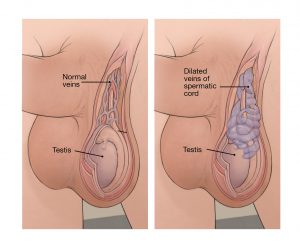Varicoceles
 A varicocele is enlarged veins in the scrotum, the loose pouch of skin
that contains the testicles. Similar to varicose veins in the legs, varicoceles
are caused when valves controlling blood flow along the testicular cord
fail to operate normally, causing a backflow of blood and swollen veins.
This causes elevated temperatures that are thought to interfere with normal
sperm production and inhibit the production of testosterone.
A varicocele is enlarged veins in the scrotum, the loose pouch of skin
that contains the testicles. Similar to varicose veins in the legs, varicoceles
are caused when valves controlling blood flow along the testicular cord
fail to operate normally, causing a backflow of blood and swollen veins.
This causes elevated temperatures that are thought to interfere with normal
sperm production and inhibit the production of testosterone.
About 20% of men between the ages of 15 to 25 develop varicoceles above the left testicle, and occasionally in both testicles.
Symptoms
Most men with varicoceles often have no symptoms and most varicoceles go unnoticed until a physical exam or a fertility workup. Symptoms may include:
- Aching or feeling of heaviness in the testicle, especially after standing for a long time
- Atrophy (shrinkage) of the testicle
- Visible or palpable enlarged veins that may look like “a bag of worms”
- Infertility
- A mass in the scrotum
Diagnosis
In most cases, your doctor can detect the varicocele through a physical exam. They may ask you to take a deep breath and bear down (called the valsalva maneuver) to improve detection. If the exam is not conclusive, he may order an ultrasound of the testicles to provide a painless view of their internal structures.
Varicocele Treatment
While most varicocele do not require treatment, you may want to undergo treatment to improve symptoms like pain, infertility, or testicle atrophy.
Surgical treatments include:
- Microsurgical varicocelectomy is usually considered to be the best treatment for relieving pain caused by the varicocele, and also to improve semen parameters, testicular function, and pregnancy rates in couples with male factor infertility associated with varicocele. A microsurgical varicocelectomy is performed on an outpatient basis under general anesthesia. A small incision is made just above the pubic bone. The veins are then isolated and tied off so that the varicose veins are permanently closed and blood flow is redirected to the unaffected veins.
- Laparoscopy is performed less often because it can present more risks. Laparoscopy may have the advantage of identifying veins higher up, where your surgeon likely will need to tie off fewer veins. The urologist makes several tiny incisions in your abdomen, using tiny instruments under general anesthesia to repair the varicocele.
- Percutaneous embolization is usually performed when other approaches have failed. A radiologist passes a tube through a vein in the groin to the affected area and releases a coil or balloon to block off the affected vein.
